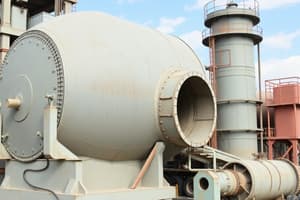Podcast
Questions and Answers
What is the origin of polymers mentioned in the text?
What is the origin of polymers mentioned in the text?
They come from petroleum.
What materials did early humans have access to?
What materials did early humans have access to?
Stone, wood, clay, skins.
What is the effect of heat on the properties of materials?
What is the effect of heat on the properties of materials?
- It only makes materials weaker.
- It cannot alter the properties.
- It can alter the properties. (correct)
- It only makes materials stronger.
Automobiles exist because of expensive steel.
Automobiles exist because of expensive steel.
Which element does 'H2O' represent?
Which element does 'H2O' represent?
What properties do metals generally have?
What properties do metals generally have?
How are ceramics characterized?
How are ceramics characterized?
Which materials are included in the category of composites?
Which materials are included in the category of composites?
The response of a material to an applied magnetic field is known as __________.
The response of a material to an applied magnetic field is known as __________.
What are the five levels of structural classification of materials?
What are the five levels of structural classification of materials?
What is defined as the ability of a material to resist deterioration over time?
What is defined as the ability of a material to resist deterioration over time?
Study Notes
History of Materials
- Origins of polymers trace back to petroleum sources.
- Historically, humans utilized limited natural materials, such as stone, wood, clay, and animal skins.
- Material properties can be modified through heat treatment, temperature changes, and the addition of other substances.
- The automotive industry finds its foundation in the affordability of steel.
- Advanced electronic devices depend on semiconducting materials for their components.
Classification of Matter
- Matter can be divided into mixtures and pure substances.
- Examples of mixtures include air and bronze; pure substances can be elements or compounds.
- Compounds consist of combinations of elements, such as H2O (water) and CO2 (carbon dioxide).
Classification of Materials
- Metals, like steel, aluminum, gold, and iron, are noted for their toughness and electrical conductivity; they can also form various oxides and nitrides.
- Ceramics, such as porcelain, are strong yet brittle when crushed.
- Polymers, including plastics and rubber, are derived from petroleum waste and are characterized by flexibility and stretchability.
- Composites like bone, wood, and fiberglass provide a combination of rigidity and reinforcement, integrating different material properties.
Engineering Applications
- Material scientists focus on the development and synthesis of new materials for various applications.
- Engineering design choices consider performance, construction, and the existing materials available.
- Material engineers create systems and products by evaluating material properties for optimal results.
Mechanical Properties
- Mechanical deformation occurs when materials experience applied loads or forces.
- Key mechanical properties include elastic modulus (stiffness), strength, and resistance to fracture.
Electrical Properties
- Materials are evaluated based on their ability to conduct electricity and their dielectric constants.
Thermal Properties
- Thermal characterization includes heat exchange capabilities, thermal conductivity, thermal expansion, and heat capacity.
Magnetic Properties
- Magnetic responses are influenced by the application of magnetic fields, with common properties being magnetic susceptibility and magnetization.
Optical Properties
- Optical properties relate to light interaction, including transparency, index of refraction, and reflectivity.
- Notably, humans are typically transparent to certain types of electromagnetic radiation.
Deteriorative Properties
- Long-term performance of materials can change due to environmental reactions, such as corrosion resistance in metals.
Structural Aspects
- The structure of materials is contingent upon processing methods and is categorized based on internal composition arrangements.
- Five levels of structural classification include:
- Subatomic: Focuses on electrons within atoms and their interactions.
- Atomic: Concerns the organization of atoms into molecules or crystals, with varying properties (e.g., carbon in diamond form).
- Nanostructure: Consists of aggregates and particles at the nanoscale, influencing unique material characteristics.
Studying That Suits You
Use AI to generate personalized quizzes and flashcards to suit your learning preferences.
Related Documents
Description
Explore the fundamentals of materials in this quiz based on Chapter One of the History of Materials. Learn about natural resources, their properties, and how they have been manipulated through human ingenuity. Test your knowledge on the origins and applications of various materials.




